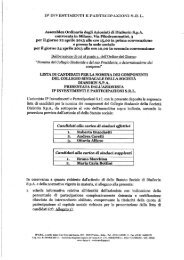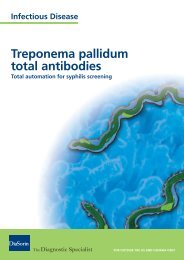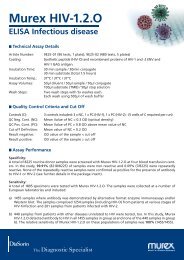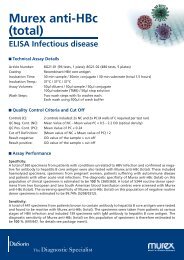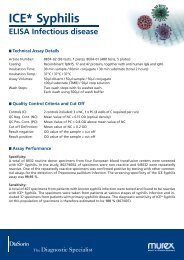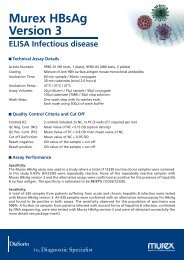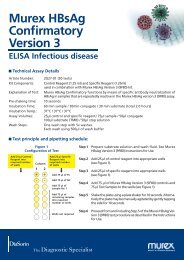Syphilis Booklet - DiaSorin
Syphilis Booklet - DiaSorin
Syphilis Booklet - DiaSorin
Create successful ePaper yourself
Turn your PDF publications into a flip-book with our unique Google optimized e-Paper software.
in the infection incubation period where the<br />
IgM test could be a false negative simply because<br />
antibodies have not developed yet.<br />
• A newborn without symptoms with negative<br />
ELISA IgM, whose mother received no or inadequate<br />
treatment in the latent period of the<br />
disease. This represents a risk of syphilis for<br />
the newborn.<br />
• A newborn with or without symptoms, with<br />
positive ELISA IgM, whose mother is seropositive<br />
and untreated, will probably suffer from<br />
congenital syphilis.<br />
• The evidence of a cellular and protein increase<br />
in CSF added to reactive VDRL and/or<br />
positive IgM would facilitate diagnosis confirmation<br />
in all these cases (Cf. Table 15).<br />
3.2.9. Diagnosis peculiarities in HIVpositive<br />
individuals<br />
Treponemal infection in HIV-positive<br />
individuals is greatly prevalent, probably<br />
because both pathogens share certain<br />
acquisition factors that are very common in<br />
the population under review. Most HIV<br />
patients respond well to treponemal infection.<br />
There are exceptions, however, such as the<br />
presence of particularly high or low titres,<br />
reaginic test false positive results, gradually<br />
disappearing reactivity in treponemal tests,<br />
the persistence of reaginic test titres despite<br />
adequate treatment and no serological<br />
response in proven syphilis cases. All these<br />
circumstances complicate diagnosis in some<br />
patients, and cause the risk of results being<br />
improperly taken to be false positive results.<br />
Clinical data and caution are even more<br />
fundamental, due to the fast progression of<br />
syphilis in these patients.<br />
4. Treatment monitoring<br />
Only RPR and VDRL reaginic tests are<br />
fundamental in evaluating treatment efficacy.<br />
VDRL titres should decrease significantly at<br />
least four times 3 to 4 months from treatment<br />
Table 15: Defining a congenital syphilis<br />
case (CDC, 1993)<br />
• Confirmed case<br />
• Visualization of T. pallidum<br />
in lesions of placenta, cord,<br />
nasal secretion, etc.<br />
• Hypothetical diagnosis<br />
• A child whose mother has received<br />
no or inadequate treatment<br />
• A child with positive serological<br />
tests and:<br />
Physical evidence<br />
CSF with positive VDRL<br />
CSF with cellular or biochemical<br />
alterations<br />
Osteitis of long bones<br />
• A child with a:<br />
VDRL or RPR more elevated<br />
than in the mother<br />
Positive IgM<br />
onset, and eight times after 8 to 12 months if<br />
therapy is adequate and effective. RPR<br />
decreases less and both tests are less accurate<br />
in HIV-positive individuals. 39<br />
Titres generally<br />
decrease slightly in 25 to 40% of patients if<br />
treatment begins in the latent or late stages,<br />
or in cases of repeated infections with<br />
moderate or low reaginic titres. Many properly<br />
treated patients commonly present reactivity<br />
persistence for some time at titres of 1/2 or<br />
neat serum, but this is not failed treatment or<br />
re-infection. The same antigen type should<br />
always be used to perform this evaluation<br />
considering the different RPR and VDRL<br />
sensitivity levels. ELISA IgM can also be used to<br />
assess therapy efficacy if it is administered<br />
during the primary stage or very early in the<br />
secondary stage. Concentration of this<br />
antibody decreases significantly in 75% of<br />
patients.<br />
23



